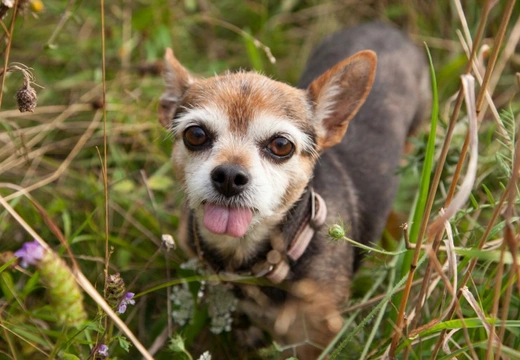
Dog Tongue Sticking Out? Understanding Hanging Tongue Syndrome
Dogs hang their tongues out of their mouths for a whole host of reasons, and seeing your dog with their tongue sticking out is probably an everyday occurrence for you. This is a totally normal canine behaviour that dogs exhibit for a variety of reasons, some of which we will look at in more detail later on. However, if your dog’s tongue is permanently extended or they are physically unable or unwilling to retract their tongue into their mouth, they may be suffering from what is known as hanging tongue syndrome.
Hanging tongue syndrome is a medical defect that can arise in dogs due to a variety of reasons, and which can indicate a problem with your dog’s conformation or neurological system, or that they have suffered from an injury, all of which can go on to cause further problems.
If your dog cannot retract their tongue, whether this is a new development or has been the case ever since you have had your dog, they may have hanging tongue syndrome – and in this article, we will examine what this means, how it affects dogs, and what can be done about it. Read on to learn more.
Normal tongue positions and behaviour
As mentioned, all dogs stick or hang their tongues out of their mouths, and there are a wide variety of different reasons and situations that cause this to happen.
Because dogs pant to cool down and their tongues have a large surface area, panting with the mouth open or sticking the tongue out helps to promote cooling, as your dog inhales cooler air that in turn works to cool the dog’s body down by heat exchange inside of the mouth and across the tongue’s surface.
Dogs will also sometimes stick out their tongues or open their mouths to pick up a faint or interesting scent, as dogs also have a scenting organ called Jacobson’s Organ in the back of their mouths. Opening the mouth allows dogs to pick up scent particles that are “read” by this organ, and sticking the tongue out allows it to pick up minute scent particles too.
If your dog smells something delicious or you are cooking dinner, this also triggers your dog’s scenting abilities, and may make them salivate and slobber as well as sticking their tongues out!
These normal behaviours, and many others, can all lead to your dog sticking their tongue out, and this is fine and normal – because your dog has control of the mobility of their tongue, and can extend and retract it when they want to.
Hanging tongue syndrome
Hanging tongue syndrome occurs when the dog cannot retract their tongue and is physically unable to bring it back into their mouth, leading to their tongue hanging out permanently. This places them at risk of their tongue drying out, and cracking or becoming sore – as well as increasing the risk of damage and injury, including sunburn.
Dogs who cannot retract their tongues may also have problems eating or drinking, and be unable to groom themselves.
The symptoms of hanging tongue syndrome in dogs
There are several symptoms that can accompany hanging tongue syndrome, which can let you know that something is amiss.
- The tongue hanging or sticking out of the mouth at all times is the most obvious symptom.
- Because the tongue dries out and is exposed to the air, the tongue will also look and feel dry, and may potentially be rough, sore or have sore spots and patches.
- The tongue may appear pale and swollen, or otherwise different to normal.
- Dogs who cannot retract their tongues back into their mouths properly may be dehydrated, as they lose moisture through their tongues continually.
- Foul breath also often accompanies hanging tongue syndrome in dogs.
What cause hanging tongue syndrome in dogs?
Hanging tongue syndrome can occur due to an injury or illness that damages the nerves in the head and face, or because of a conformation disorder that prevents the dog from fully closing their mouth or retracting their tongue.
Injuries such as impacts and falls can cause this type of damage, as can some neurological conditions that affect motor control and muscle control, or the nerves in the brain, head and face. Certain breeds and types of dogs also have muzzles that are short compared to the length of their tongues, including many brachycephalic breeds like the English bulldog, which can contribute to the problem.
If your dog’s tongue won’t retract or is always hanging out, it is important to get your dog seen by your vet, so that they can identify the underlying cause of the issue and if necessary, treat the root problem.
For certain health conditions and injuries, treatment or correction may be possible, while for conformation defects or conditions that cannot be reversed, care for a dog with hanging tongue syndrome may be based around mitigating the problems that the hanging tongue can cause. This may mean keeping the tongue moist, feeding soft foods and otherwise supporting the dog’s needs, to keep them comfortable and minimise the impact of the condition on their day to day lives.



